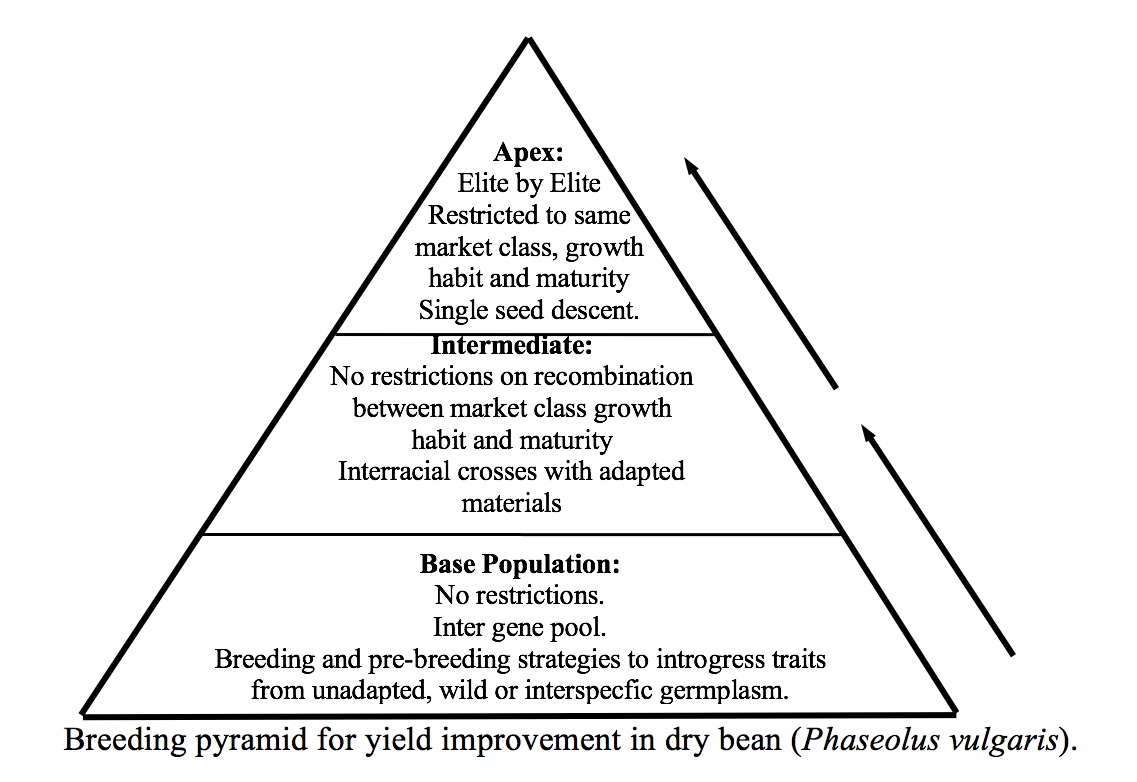Breeding For Yield
Preamble: Dry beans are grown as a row crop in North America. The crop has to compete in performance with other commodities where substantially more investment has been made in breeding. In the absence of any price support, dry beans are usually produced in higher latitudinal or altitudinal regions where other crops are less competitive. Yield is a critical economic trait that needs to be improved in order that farmers will continue to produce the crop. In Michigan, dry bean yields are not competitive with those of soybeans on an absolute basis but when compared to those of soybean on a yield/day basis they are equally competitive. Providing farmers with a high-yielding alternative crop that fits into their farming calendar allows for greater crop diversity. Many of the genetic challenges facing bean breeders result from the short-season nature and seed type and growth habit diversity of the crop and a breeding strategy to address those challenges is discussed in the article ‘Breeding for yield in dry bean’. Breeding for yield will continue to be the number one trait in most bean breeding programs.
Strategies employed by dry bean breeders to improve yield include early generation testing, ideotype breeding, selection for physiological efficiency, and selection based on genotypic performance and combining ability across gene pools of Phaseolus vulgaris(Kelly, 2018). Ideotype breeding has been successfully deployed to improve yield in navy, pinto and great northern seed types. The ideotype method is based on an ideal plant architecture to which breeders target their selection. Breeding for physiological efficiency is important in combining increased biomass, high growth rates and efficient partitioning. Genotypic performance and combining ability are also critical for yield improvement, since crosses between gene pools can exhibit negative combining ability and problems with lethality, whereas interracial crosses within the same gene pool exhibit the greatest potential. Breeders must work within specific constraints for growth habit, maturity, seed quality and disease resistance. A three-tiered pyramidal breeding strategy is proposed to facilitate yield improvement in dry bean (Kelly et al., 1998). Breeding of elite, agronomically acceptable germplasm within the same market class is restricted to the apex of the pyramid. The intermediate level has fewer constraints and greater access to diverse germplasm. Interracial crosses within the same gene pool are utilized to exploit genetic differences within adapted material. Extracting genetic diversity from unadapted sources, including wild germplasm and other Phaseolus species, is conducted at the base of the pyramid. The objective of this breeding strategy is the movement of improved germplasm towards the apex, using different breeding procedures to optimize improvement at each tier of the breeding pyramid.

References:
Kelly, J.D., J. Kolkman, and K. Schneider. 1998. Breeding for yield in dry bean (Phaseolus vulgarisL.). Euphytica 102:343-356.
Kelly, J.D. 2018. Developing improved varieties of common bean, 2:3-17. In: Achieving sustainable cultivation of grain legumes. Vol. 2: Improving cultivation of particular grain legumes. Editors: Sivasankar S., Bergvinson D., Gaur P., Agrawal S.K., Beebe S., Tamò M. Burleigh Dodds Science Publishing, Cambridge UK, pp. 376.



 Print
Print Email
Email